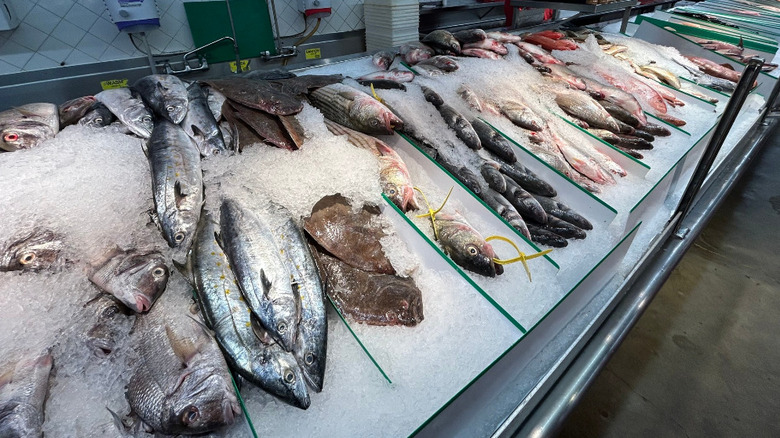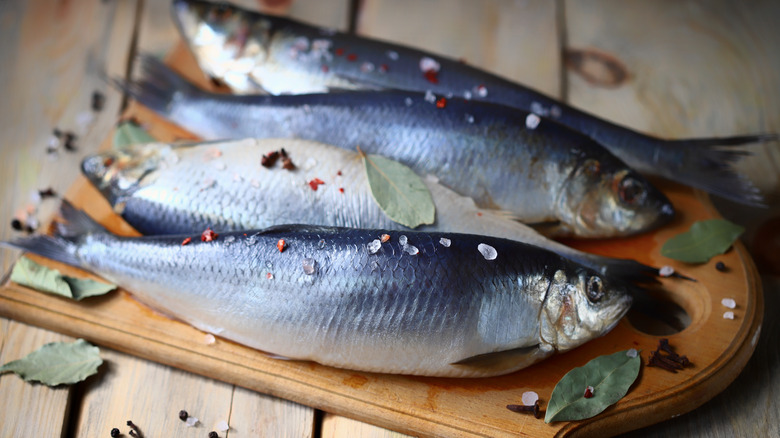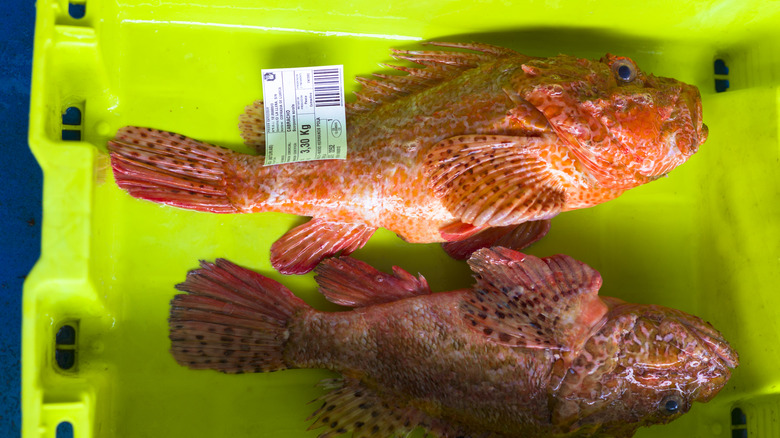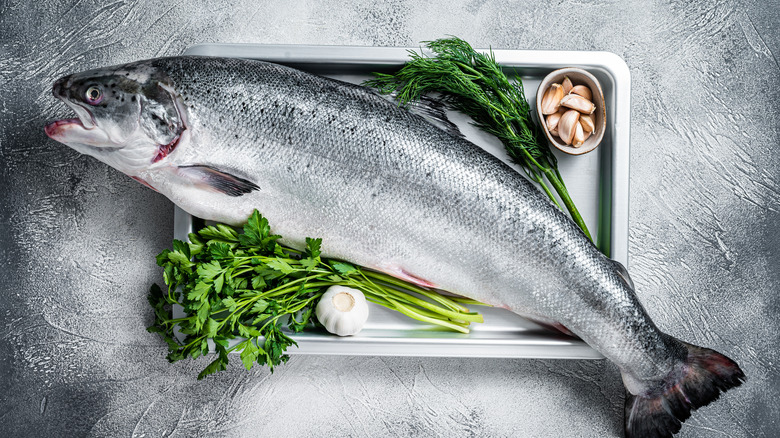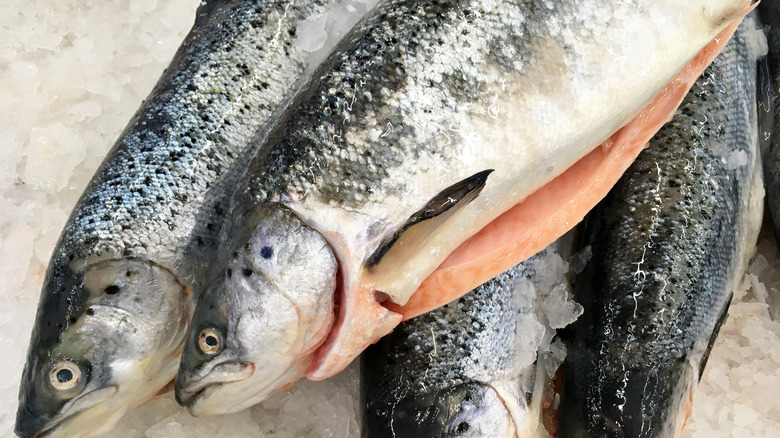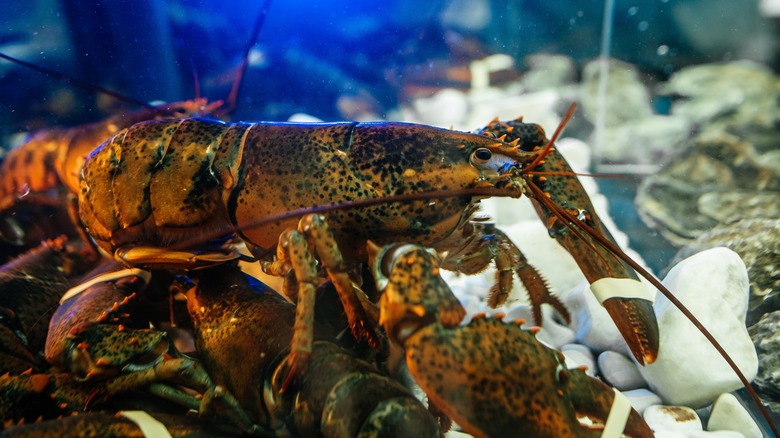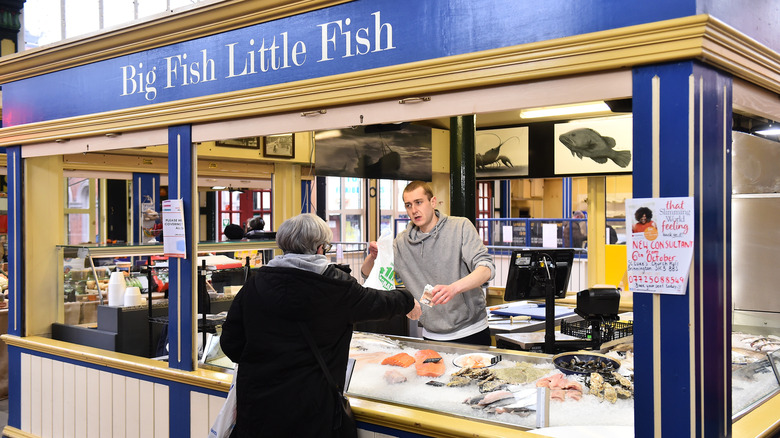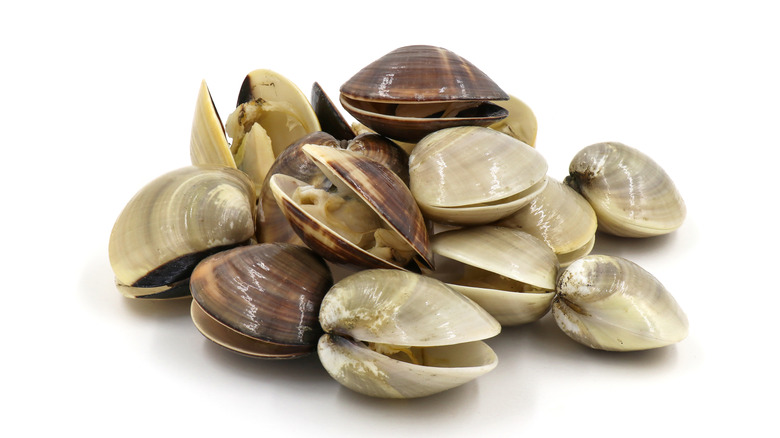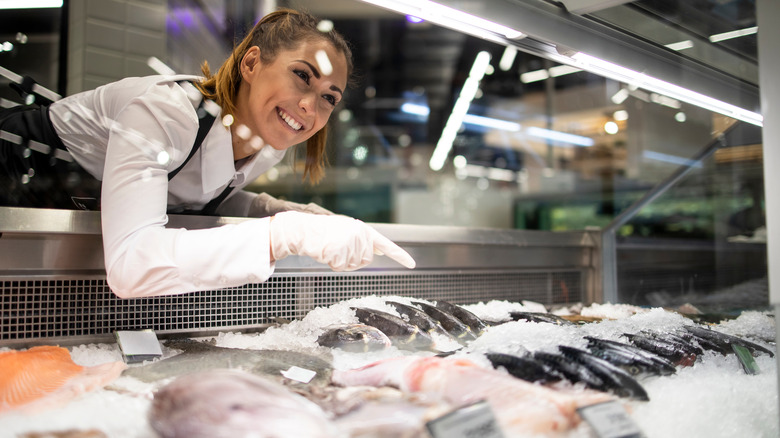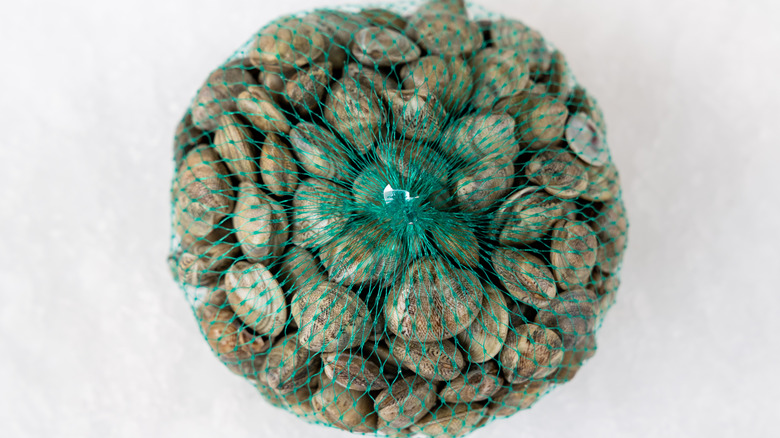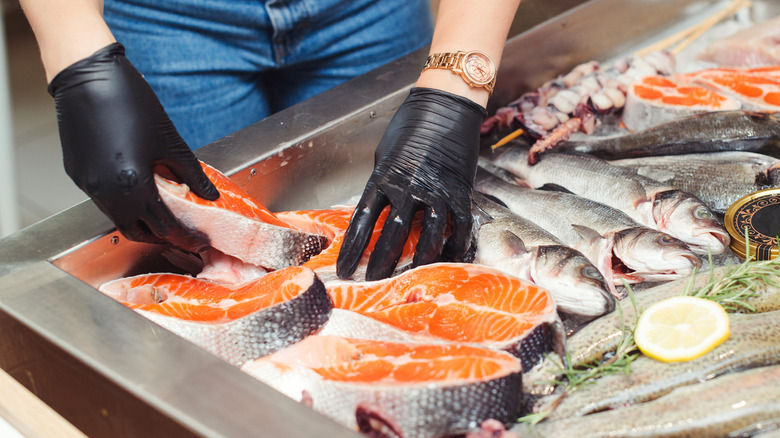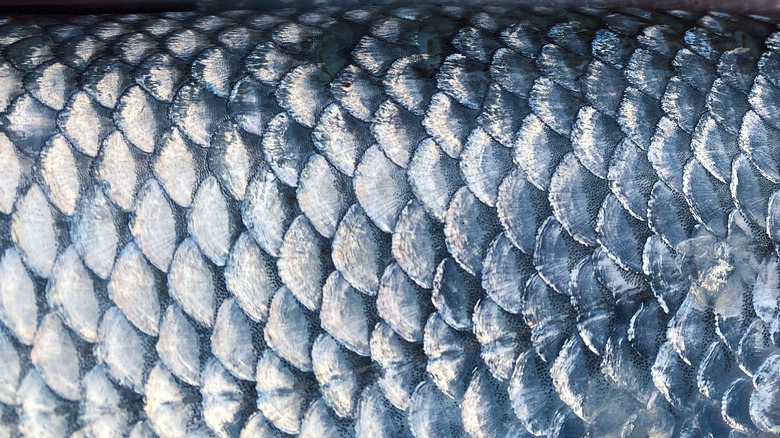12 Red Flags To Look Out For When Buying Fresh Seafood
Shopping for fresh seafood can feel overwhelming and confusing, especially if it's your first time approaching the seafood counter at the grocery store or fish market. There are dozens of options to choose from, including various kinds of whole and sliced fish, shellfish, and crustaceans; and it can be hard to remember which ones should be alive and in tanks, and which should be on ice. While you might know that fish shouldn't smell off-putting, you may not know what healthy fish eyes, gills, and dorsal fin look like; these features can be tell-tale signs of how fresh the fish is and how it will taste.
If you love eating seafood, buying it shouldn't be a barrier to making your favorite dishes at home. By keeping a few simple dos and don'ts in mind next time you're shopping, you can help ensure you are buying the freshest seafood. These are the most important red flags to look out for when buying fresh seafood.
1. It's smelly
Fish should not smell, well, fishy. Fresh-caught seafood will smell like the ocean — fresh and mild, with a bit of a salty odor — if you're buying saltwater varieties. Your fresh fish should certainly not smell sour or like chemicals, which could be a sign that the flesh has started to degrade.
According to the American Society for Nutrition, the reason that fish start to smell after being caught is due to a substance in their tissues called trimethylamine oxide (TMAO). TMAO is converted to another substance, trimethylamine (TMA), when the fish are removed from the water and killed. TMA has a fishy odor that gets stronger over time. The longer the fish is out of the water and in the open air (and therefore less fresh), the more TMA it will contain. This, in turn, leads to a stronger smell. To avoid seafood that might be on the older side, ask your fishmonger if you can give the fish a whiff before you purchase it.
2. The eyes are cloudy
Healthy, living fish have clear, mostly-white eyes with dark irises. However, after they're caught, the eye color will start to change pretty rapidly. The longer a fish has been sitting around out of the water after harvest, the cloudier and more yellow its eyes will become. To ensure that you're getting the freshest catch when buying a whole, head-on fish to roast or grill, Michelin-star-winning chef Thomas Keller of The French Laundry advises shoppers to check that the fish has clear, slightly bulging eyes and flesh that bounces back when pressed, per MasterClass.
It's a good sign if the fish's eyes are still in place at the market, too, as it can be a red flag if they are missing. This is because some fish stores try to get away with pawning off less-than-great products by covering or removing the eyes. In fact, according to the New York Post, one Kuwaiti supermarket was caught pasting googly eyes onto the heads of whole fish to cover up old, yellowing eyes and make them look fresh.
3. The gills aren't red and frilly
When looking for a fresh whole fish for dinner, another feature to inspect is the gills, which should be bright red, firm, and frilly-looking. After fish are harvested, their gills will slowly turn red to darker red, then light brown, brown, dark brown, and finally green as the fish gets ages. Dull, discolored, or damaged gills are signs of an aging fish that's probably past its prime. In addition, injured gills can be a sign that the fish had a disease before it died (and may have been raised in less-than-humane conditions) or has been mishandled during transport, and is, therefore, best avoided.
Aside from the gills, the fish's bloodline is another indication of how fresh it may be. The color of the bloodline changes in the same way as the gills, turning from bright red to dark brown to green as the fish ages.
4. The flesh is gapping or dry
The flesh of seafood — from whole fish to tiny pearl scallops — should be firm, wet, shiny, and taut. It's a major red flag if you see any signs of flaking, dryness, or mealiness.
If you're suspicious that the fish's flesh you're eyeing isn't as high-quality as you would like, ask your fishmonger to gently press on the flesh with their gloved hand. According to the chefs at ChefSteps, the flesh should bounce right back and not show signs of stickiness or denting.
Without touching the fish yourself, you can also get a sense of the quality of the fish by how it looks. A bit of shine and shimmer is a good thing, while fish with drab or cloudy-looking flesh are best avoided. And while most fish have naturally flaky flesh, you should not see any gaping spaces between the muscles, which is a sign of age and/or mishandling.
5. The fish has belly burn
If you're buying a whole fish, check for belly burn, which refers to visible lumpiness and/or discoloration on a fish's stomach. This can occur if an angler waits too long to gut the fish after catching it. If you see yellowing along the fish's underside or inside the cavity, steer clear. This is a likely sign that the fish intestines started to decompose inside the fish, causing potential rotting and bacteria that you do not want to bring home for dinner.
According to the Recommended Procedures for Handling Troll-Caught Salmon, belly burn can happen as quickly as 10 minutes after the fish is caught if it is not handled properly. The guidebook instructs fishermen to immediately eviscerate fish as soon as they are brought onboard and prior to storing. Otherwise, even if all other storage procedures are followed correctly, they can begin to spoil.
6. Crustaceans are not alive
Craving a lobster roll? Before you shop, know that crustaceans, like lobsters and crabs, should be alive and moving at the store. For freshness, these crawlers should be stored in a dark, spacious tank that's fed constantly with a stream of clean, running water. Before you choose your lobster to bring home, be sure that you can see both the sea creatures and the water moving in the tank. This is because stagnant water can become a breeding ground for bacteria and disease.
To know for sure that the crustacean is alive, ask the fishmonger to remove one from the tank. It should immediately start flapping its tail and moving its arms and claws around. According to Chef Mark LoRusso, per an Esquire interview, after a lobster or crab dies, its flesh immediately starts to degrade, which can leave you with mushy, limp flesh. The longer it lingers after dying, the more likely it is to smell, as well.
7. There's little foot traffic
Before you even set foot in the shop to buy seafood, consider the turnover of products and the amount of foot traffic in the store. Fresh seafood does not have a lengthy shelf life, so your best bet is to shop at a place that's frequented and gets in a new catch delivered daily. Another way to double-check the rate of turnover at your fish counter is to ask the person selling the seafood when their most recent catch came in. "This morning" is the answer you're looking for.
According to commercial fisherman Tony Maltese, per a CNBC interview, your best bet is to shop at a fish store that's well-known, crowded, and has plenty of repeat business. A shop won't rack up satisfied regular customers by selling bad or past-their-prime seafood. If you're new to a place, asking the locals about a store's reputation is a great way to vet things before you shop.
8. The clams are open
Before they're cooked, shellfish, like clams, oysters, and mussels, should all have tightly closed shells. Of course, the opposite is true after cooking, when you only want to eat opened bivalves (so toss out any that don't pop open when you're making linguine with clams).
If you notice any slightly open shellfish, give them a gentle tap on the shell, or ask the fishmonger to do so; it should immediately clam up. If the seafood doesn't respond, there's a good chance that it's already dead and no longer fresh or safe to eat.
According to Chef Dusmane Tandia Abdoulaye of Mastro's Steakhouse in NYC, per an FSR interview, the shellfish you're buying should also have clean shells without grit, seaweed, or dirt. Because clams need to breathe oxygen to stay alive, they should not be stored in an airtight container and the shells shouldn't be covered in so much debris that they can't get air.
9. The fishmonger isn't knowledgeable
When shopping for seafood, you should be able to have an informative discussion with the person behind the counter about what's for sale and how fresh it is. In particular, the fishmonger should be able to tell you what's in season locally. Fish, like produce, have better and worse times of year for harvest, as their population waxes and wanes. So whatever is in season at the moment will have the best flavor and likely be the freshest. You'll also want to dig deeper into where the fish was caught and when it arrived at the store. The catch that came in that morning is your freshest choice.
If your fishmonger isn't in touch with the current seasons or doesn't know when the fish arrived it's a red flag. They may not be able to guide you toward the best option, so you may be better off shopping elsewhere for seafood.
10. The label is missing or incomplete
The FDA has issued strict rules that require labels on bags of fresh, living shellfish, as well as containers of previously shucked shellfish (you might find these in the fridge or freezer section of the store). These labels are required to include details about where the product came from, when it was caught, and how it was harvested and processed.
Together, these data points offer a way to track all kinds of seafood from the moment they are removed from the water to when they arrive at a shop. It is a great tool for fishmongers to keep track of their inventory, and it allows shoppers to learn more about the seafood's origins and how fresh it may be. If the label is missing or incomplete, this could be a red flag. It could mean the seafood is on the older side and the market is trying to push them, or it could mean it was mishandled, which could lead to poor quality.
11. The fish isn't kept cold
Because seafood will degrade and become smelly and inedible quite quickly, proper storage is essential from the moment it's removed from the water. All seafood must be kept cold on ice from immediately after harvest until it goes into your oven or frying pan. This keep is fresh and prevents bacteria from growing. If the fish at your market is not kept on a bed of ice (or in fresh tanks of running water in the case of lobsters and crabs), take that as your sign to find another purveyor.
However, the mere presence of ice at the fish store is not enough on its own. Go ahead and take a closer look at it; it should look clear and fresh, not yellow or cloudy. Odd colors on the ice suggest that the store may not be changing it as often as necessary, which can cause food contamination.
12. The fishmonger won't scale or gut it
It's not necessarily an instant red flag if the fish you're considering still has its scales intact at the store. However, it is a red flag if your fishmonger won't remove them for you, as it's totally appropriate to ask (and often expected). If you don't take advantage of this service, you'll have the daunting task of removing the scales at home, which can get messy fast. Descaling seafood also requires some specialty knife skills and a very sharp knife.
While you're getting the fish scaled, double-check with the fishmonger that your dinner has also been fully gutted. The fish should have a slit in its stomach from head to tail. Inside, the cavity should be clean and organ-free. Again, it's appropriate to ask your fishmonger to take care of the intestines for you. And if you don't, you'll be doing some extra butchery at home.
